Moto X Review
by Brian Klug on August 26, 2013 1:30 PM EST- Posted in
- Smartphones
- Qualcomm
- MSM8960
- Motorola
- Android
- Mobile
- Android 4.2
- Moto X
Battery Life
Battery life is a huge concern in the smartphone space these days, especially as phones get bigger and more powerful. The Moto X includes a unique 2200 mAh, 3.8 V (8.36 Whr) stacked battery made by LG chem, which maximizes battery volume given the Moto X’s rounded form factor. Motorola was very vocal about the battery life of the Moto X, and made the claim of up to 24 hour of mixed use with the device in addition to up to 13 hours of call time. Given the smaller (albeit AMOLED) display and dual core SoC, the Moto X was an easy target for the narrative that higher end specs and quad core SoCs are killing smartphone battery life, which many immediately latched onto and parroted claims of amazing battery life.
Of course, the real question is how the Moto X stacks up to the competition in our objective tests. I have to admit that my initial subjective impressions of the Moto X battery life were not all that great. My first time daily driving the Moto X was after getting it in NYC and flying home – I left the hotel with it fully charged, spent 4 hours in a plane with it in airplane mode, and Moto X still died in the baggage claim before I could make it home. The second time I daily drove the Moto X, I also managed to kill it doing nothing out of the ordinary before I got back home. I honestly can’t remember the last time I drained a phone completely actually using it. Since those couple of times I haven’t had problems making it through a full day when I’ve daily driven the Moto X, but that’s with my usual opportunistic charging from every available wall socket and USB port, and my mixed use definitely isn’t 24 hours, rather closer to 8.
Our objective battery life tests are unchanged so I’m not going to go through all of it in excruciating detail again – you can read any previous review and get the details. At a high level we calibrate the display to exactly 200 nits, then run through a bunch of webpages with content every dozen or so seconds until the device dies, on both cellular, and WiFi. The call test is self explanatory – there’s voice at both the originating terminal and terminating terminal, and we time how long the call goes for until the device dies.

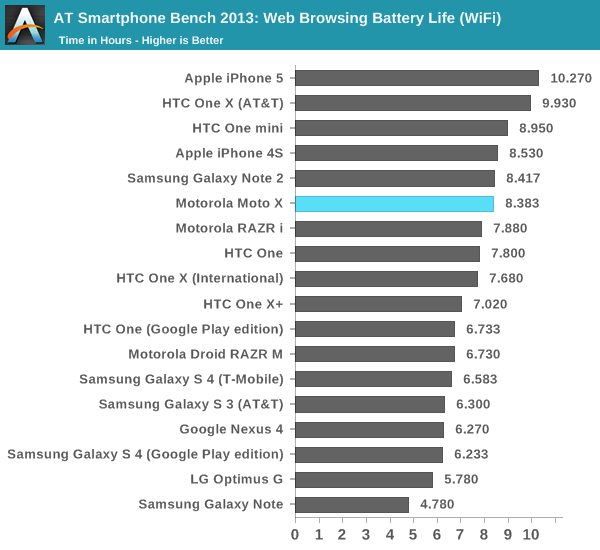
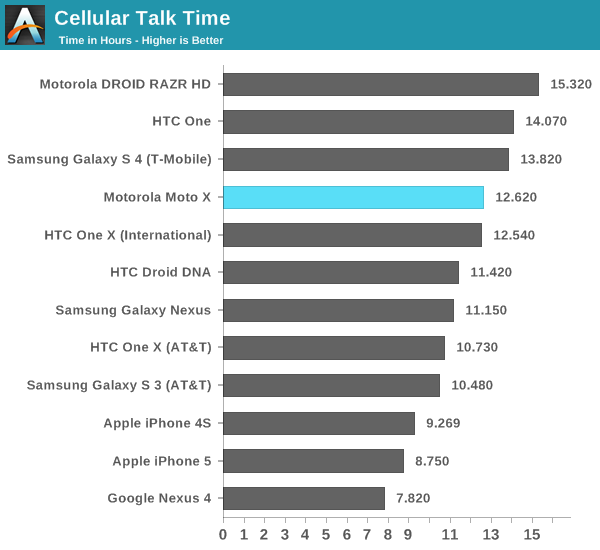
Battery life on the Moto X doesn't turn out to be all that much different from the other flagships based on APQ8064 on LTE. In fact, it's about par. That's not too surprising for me considering compared to the HTC One and SGS4 it's the same CPU (Krait 300) and process (28nm LP). For better battery life we'll need better efficiency, which will come either through newer process (28nm HK-MG variants at TSMC) or even more efficient CPU architecture.
In reality, having fewer cores here means in something multithreaded like our battery test (Chrome is very multithreaded) it needs to send the Moto X's two cores to a higher frequency and voltage state than the four on the other devices. I'm not surprised at all to see invalidation of the "fewer cores translates to better battery life" narrative others have crafted. The only validation is that having two fewer cores does translate to less dynamic range in power use. It all becomes a matter of how you're using the device at that point, however. On WiFi the Moto X does do pretty well, and Motorola has always had very good talk time.
One thing I will note is that the Moto X does have a power saver mode, but it appears to just disable background sync and put the data connection to sleep aggressively. It doesn't change the governor so that the max CPU frequency is lower (say the 1.1 GHz state) like a lot of other OEMs power savers do, which seems like a missed opportunity.
The Moto X comes with a dual-USB port 850 mA charger, like the previous revision of Motorola devices. In practice I've seen the Moto X reliably pull closer to 1 A from the Moto X bundled charger.
What's interesting however is that the Moto X can charge up to the maximum BC1.2 rate of 1.5A. If you use that kind of charger, it charges impressively fast, around 2.3 hours.
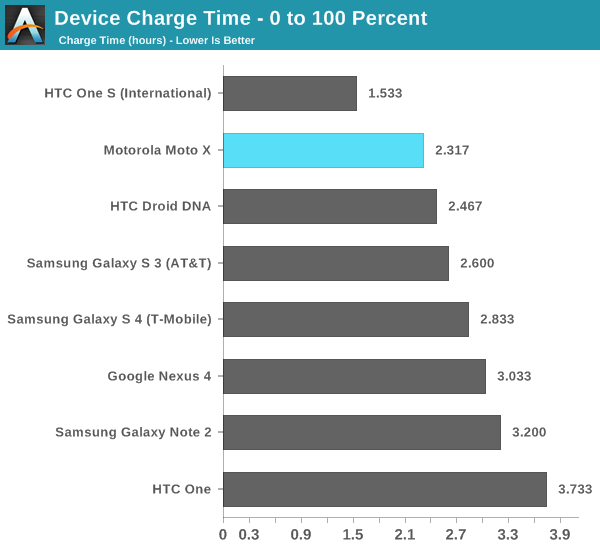


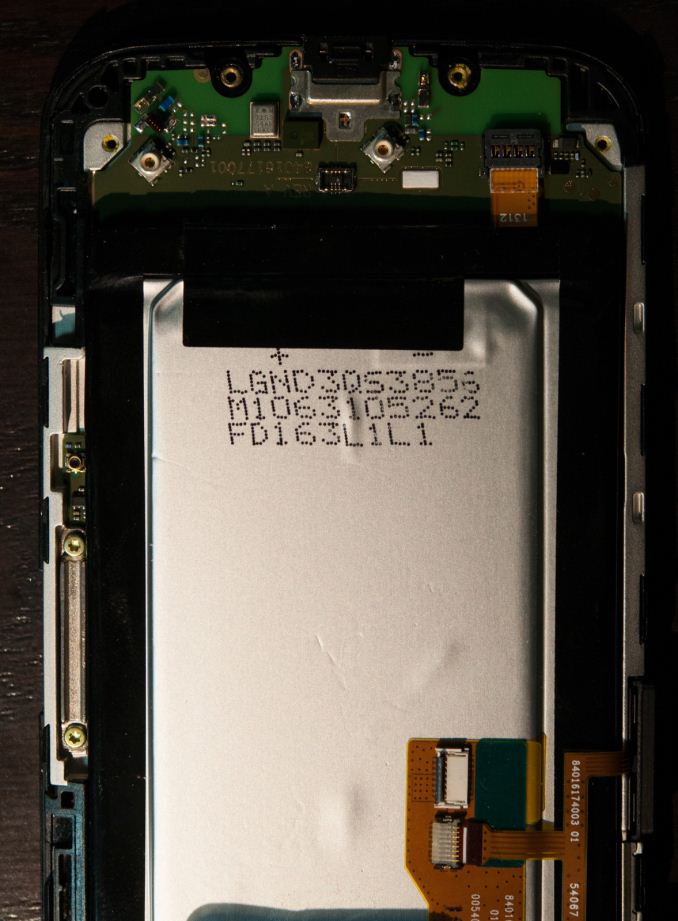
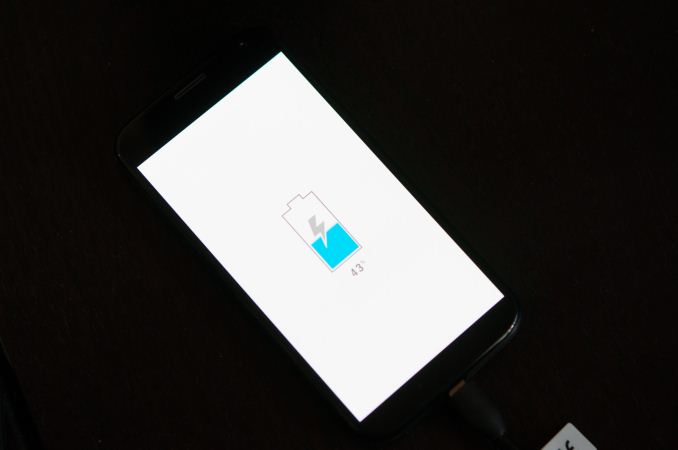








105 Comments
View All Comments
Friendly0Fire - Monday, August 26, 2013 - link
I looked for a good replacement for my Nexus S which also had good sound quality and damn that's a hard task especially in NA. I just couldn't find anything short of ordering an international SGS4 and that's just way too expensive.It always makes me sad that we strive for these huge and pretty screens but entirely botch the audio outputs in most smartphones.
kwrzesien - Tuesday, August 27, 2013 - link
Second this. A comparison to tablets would be a great contrast too...we find the iPad 3 headphone out to a Yamaha/Klipsch system superior to any phone (iphones and Androids), would be interested to see the results of the Nexus and Note tablets. Maybe including a comparison of Bluetooth (3/4) and Wi-Fi wireless sound too.tuxRoller - Monday, August 26, 2013 - link
No comment about its superior dynamic range? To my eye, it looked better than even the pureview 1028.Of course, you can't get past the moire artifacts, and lower spatial resolution.
Dan123 - Monday, August 26, 2013 - link
How about the standby efficiency and how it affects battery life. I've seen some reports that it's not so good. You mentioned in the conclusion that you compared battery life without and without the touchless controls, I'd be interested to see how this feature affects standby efficiency.PC Perv - Monday, August 26, 2013 - link
I can't get over the whole irony around the mid-range phone and mid-range screen size. I thought the criteria used to determine "high-end," "mid-range" was the price. The reviewer says this phone is first high-end phone that doesn't sport a large screen, then turn around to say the price is a bit high. Can you get that? It is a high-end phone but the problem is that it's priced as one.Too funny.
Sm0kes - Monday, August 26, 2013 - link
I think your missing the meaning of "high-end". A high-end phone is typically in reference to hardware specifications, design, construction quality, etc.. While this is typically directly related to price (bleeding edge tech and industrial processes cost more), a high price does not automatically mean quality.Also, the facts are pretty clear (for whatever reason) that in the last couple of generations the larger phones tend to have better specs than there smaller counterparts (e.g., HTC One vs. HTC One Mini).
Mondozai - Monday, August 26, 2013 - link
I think you're missing the point.Your sentence:
"While this is typically directly related to price (bleeding edge tech and industrial processes cost more), a high price does not automatically mean quality."
Which is right, but why do you later not connect this statement with the original comment you were replying to? The Moto X is specced like a 2012 phone but is priced like a high-end 2013 phone, especially as the LG G2 is coming out in a matter of weeks and the Note 3 is announced within just 9 days. That doesn't make it a bad phone, but there's a disconnect on the pricing.
kwrzesien - Tuesday, August 27, 2013 - link
The new gold iPhone will be the *only* high-end phone when it comes out.Honest Accounting - Monday, September 16, 2013 - link
What makes the specs 2012? Number of CPU cores? screen resolution? ...mammaldood - Monday, August 26, 2013 - link
Does the Moto X support aptX like other Motorolas?